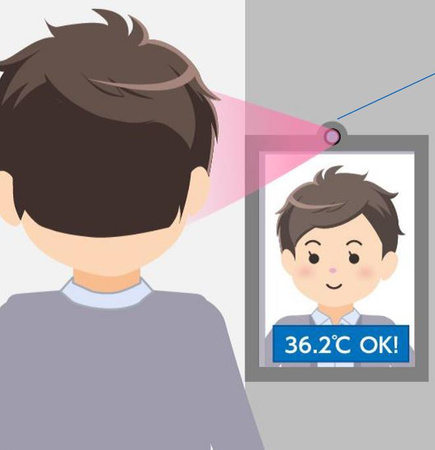COVID control with Non-Contact Temperature Sensors - David Pearson, Technical Director, Anglia Components
Non-Contact Temperature Sensing
Accurate non-contact thermal infrared sensors temperature sensors could provide a way forward. Such sensors brings the advantages of continuous non-contact temperature measurement to a variety of applications, particularly accurate occupancy and proximity sensing traditionally done using pyroelectric or passive infrared (PIR) sensors. Both types of sensors are capable of detecting the slightest temperature change in the field of view. However, whereas PIR sensors respond to temperature changes, effectively detecting the movement of a body or other warm object that contrasts with the cooler background, the D6T sensors monitor temperature continuously and so can detect a stationary presence.
For example, Omron D6T sensors are optimised for body surface temperature monitoring and can be added to an access-control system, for example, to automatically check the temperature of a visitor on arrival (figure 1). They feature a silicon lens and MEMS thermopile to detect far-infrared radiation emitted from the surface of the face or body. A signal-processing ASIC integrated in the same package converts the sensor output to a digital temperature reading and ensures a high signal to noise ratio (SNR). The result is a compact device that is well suited to embedded applications and relieves key signal-processing workloads from the system host processor.

Figure 1. Accurate non-contact temperature measurement for social distancing and protection
Accurate Body-Temperature Measurement
The typical accuracy of D6T sensors, as supplied, is ±1.5°C. To use these devices in a precision body-temperature monitoring context such as coronavirus infection checking, additional custom calibration is recommended for increased accuracy.
An effective way to calibrate the sensor is to start by setting both the upper target temp (y0) and the lower target temp (y1) to cover a suitable range. For an access-control system, designed to assess the surface temperature of a human face, a typical range could be from about 32°C to 38°C.
To calculate a correction factor and thus ensure accurate temperature measurement with D6T sensors, a calibration source such as a blackbody furnace can be used (figure 4). The source is set first to the lower limit temperature (let’s call it y0) and measured with the D6T. We recommend recording, say, 10 measurements to get an average sensor output reading (x0), making sure first to allow about 15 minutes for the system to stabilise after powering on. The source is then set to the upper maximum temperature (y1), and the average of a second set of sensor readings (x1) taken in the same way as before.

Figure 2 Calibrating with reference temperatures.
Using the reference source settings and recorded temperature measurements, the calibrated target object temperature, y, for any given sensor output reading, x, can be calculated using this formula:

Thanks to the integrated signal-processing ASIC, D6T sensors output the digital temperature value via an I2C interface that the host system can read directly. The sensor comes mounted on a PCB with terminations provided, allowing easy electrical connection.
Access Control and More
Anglia can supply the full range of Omron D6T sensors, from single-pixel to 32x32 resolution, to address the gamut of non-contact temperature-sensing applications – which could now include COVID-health monitoring as well as traditional uses. Samples and evaluation tools are available free of charge to registered account customers within EZYsample. Anglia field application engineers are trained and ready to help select the right sensor for your application and to support you throughout your project.
Visit www.anglia-live.com to discover more about D6T sensors and other Omron products available from Anglia.
